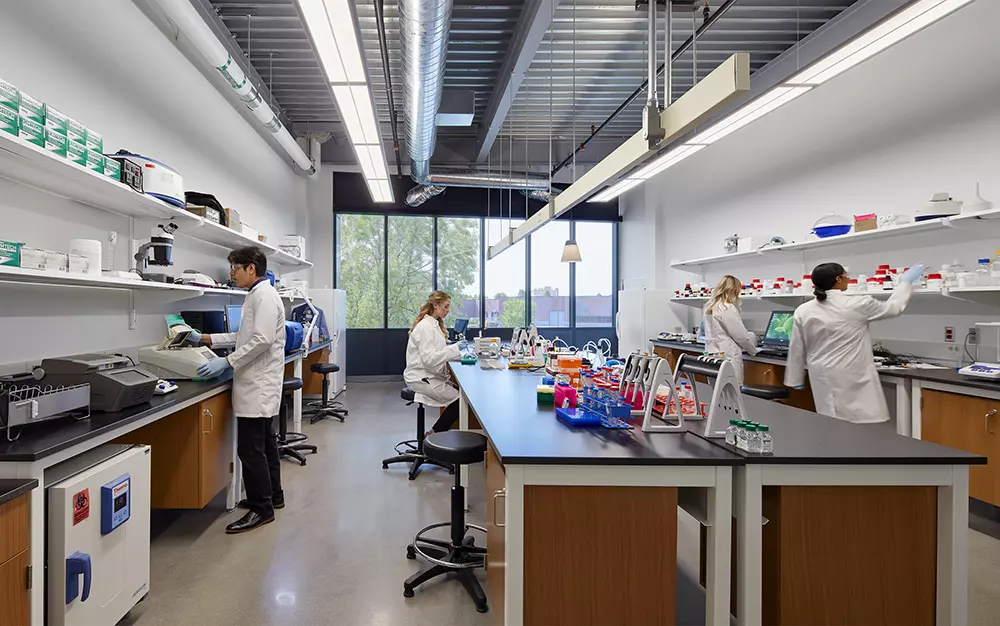1.
What is the core focus of your research or development?
Understanding whether your work leans more towards physical experiments or computational analysis is key in determining the type of lab that suits your needs. A focus on chemical reactions, biological studies, or material sciences often necessitates the diverse capabilities of a wet lab, while computational research, such as algorithm development or data modeling, thrives in the tech-centric environment of a dry lab.
2.
Will your projects involve handling chemicals, biological materials, or other hazardous substances?
If yes, a wet lab designed with safety and functionality in mind for such materials is essential. The infrastructure of wet labs, including ventilation systems and chemical storage solutions, is specifically tailored to ensure safe handling and storage of hazardous substances, critical for maintaining a secure research environment.
3.
Do you require specialized equipment for experiments, such as microscopes, centrifuges, or bioreactors?
The need for specific laboratory equipment is a strong indicator that a wet lab space is necessary. These tools are pivotal for conducting in-depth scientific research and experimentation, allowing teams to explore and innovate within the realms of their specialized fields.
4.
Is your work heavily reliant on data analysis, software development, or computational modeling?
Projects centered around digital innovation and data analysis are best suited to the infrastructure of a dry lab. The setup of a dry lab, with its emphasis on computing power and software tools, facilitates a seamless workflow for teams engaged in the digital exploration of data, software solutions, and theoretical models.
5.
What are your safety and compliance needs?
Evaluating the level of safety protocols required for your work can help decide between a wet lab’s stringent safety measures and a dry lab’s focus on data and electrical safety. Wet labs demand a comprehensive approach to chemical and biological safety, including training and emergency procedures, whereas dry labs require protocols focused on cybersecurity and protecting digital assets.

6.
How does your budget align with the operational costs of a wet or dry lab?
Considering the financial implications of setting up and maintaining your lab space can guide you towards a more cost-effective choice for your startup. Wet labs often entail higher costs due to the need for specialized equipment and safety measures, while dry labs might offer a more budget-friendly option with lower overhead for utilities and consumables.
7.
Are collaboration and team dynamics central to your work?
Reflect on whether your project benefits from the collaborative environment of a wet lab or the flexible, digital-centric nature of a dry lab. Wet labs can foster a sense of community and teamwork through shared spaces and resources, whereas dry labs may facilitate remote collaboration and offer a more modular setup for team interactions.

8.
How much space do you need, and what are your scalability options?
Assessing your current space requirements and potential for growth can influence the choice between the adaptable setups of dry labs and the more static configurations of wet labs. Dry labs often allow for easier scaling in response to project demands or team growth, given their reliance on digital rather than physical resources.
9.
Do you anticipate rapid shifts in your research direction or technology needs?
If flexibility and the ability to pivot quickly are crucial, a dry lab might offer the adaptability your startup needs. The digital nature of dry labs enables teams to adjust their focus without significant physical reconfigurations, making it easier to explore new avenues of research or adapt to emerging technologies.
10.
What long-term goals do you have for your startup, and how do each of the lab types align with these objectives?
Consider how each lab environment supports your vision for the future, from scaling operations to diversifying research areas. Whether aiming for groundbreaking scientific discoveries or leading-edge technological innovations, choosing the right lab space is a strategic decision that impacts your ability to achieve these goals, necessitating a thoughtful analysis of how each lab type can accommodate your evolving needs and aspirations.

